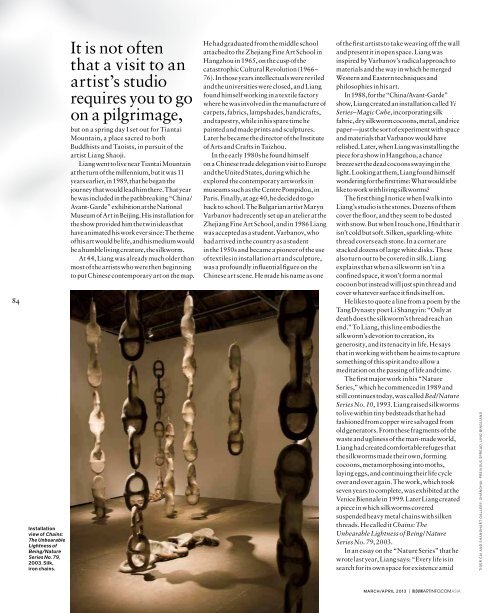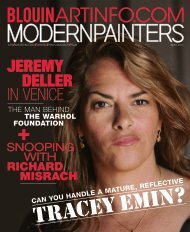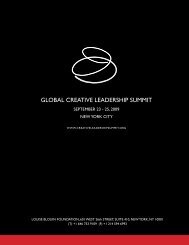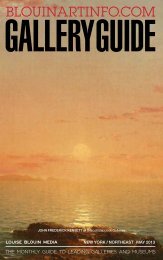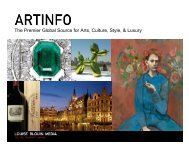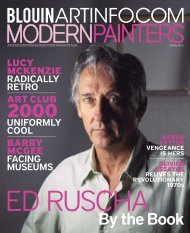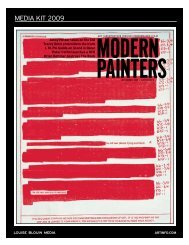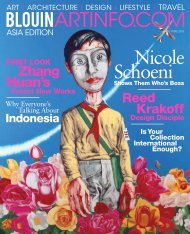Linke - Artinfo
Linke - Artinfo
Linke - Artinfo
You also want an ePaper? Increase the reach of your titles
YUMPU automatically turns print PDFs into web optimized ePapers that Google loves.
84<br />
Installation<br />
view of Chains:<br />
The Unbearable<br />
Lightness of<br />
Being/Nature<br />
Series No. 79,<br />
2003. Silk,<br />
iron chains.<br />
It is not often<br />
that a visit to an<br />
artist’s studio<br />
requires you to go<br />
on a pilgrimage,<br />
but on a spring day I set out for Tiantai<br />
Mountain, a place sacred to both<br />
Buddhists and Taoists, in pursuit of the<br />
artist Liang Shaoji.<br />
Liang went to live near Tiantai Mountain<br />
at the turn of the millennium, but it was 11<br />
years earlier, in 1989, that he began the<br />
journey that would lead him there. That year<br />
he was included in the pathbreaking “China/<br />
Avant-Garde” exhibition at the National<br />
Museum of Art in Beijing. His installation for<br />
the show provided him the twin ideas that<br />
have animated his work ever since: The theme<br />
of his art would be life, and his medium would<br />
be a humble living creature, the silkworm.<br />
At 44, Liang was already much older than<br />
most of the artists who were then beginning<br />
to put Chinese contemporary art on the map.<br />
He had graduated from the middle school<br />
attached to the Zhejiang Fine Art School in<br />
Hangzhou in 1965, on the cusp of the<br />
catastrophic Cultural Revolution (1966–<br />
76). In those years intellectuals were reviled<br />
and the universities were closed, and Liang<br />
found himself working in a textile factory<br />
where he was involved in the manufacture of<br />
carpets, fabrics, lampshades, handicrafts,<br />
and tapestry, while in his spare time he<br />
painted and made prints and sculptures.<br />
Later he became the director of the Institute<br />
of Arts and Crafts in Taizhou.<br />
In the early 1980s he found himself<br />
on a Chinese trade delegation visit to Europe<br />
and the United States, during which he<br />
explored the contemporary artworks in<br />
museums such as the Centre Pompidou, in<br />
Paris. Finally, at age 40, he decided to go<br />
back to school. The Bulgarian artist Maryn<br />
Varbanov had recently set up an atelier at the<br />
Zhejiang Fine Art School, and in 1986 Liang<br />
was accepted as a student. Varbanov, who<br />
had arrived in the country as a student<br />
in the 1950s and became a pioneer of the use<br />
of textiles in installation art and sculpture,<br />
was a profoundly influential figure on the<br />
Chinese art scene. He made his name as one<br />
of the first artists to take weaving off the wall<br />
and present it in open space. Liang was<br />
inspired by Varbanov’s radical approach to<br />
materials and the way in which he merged<br />
Western and Eastern techniques and<br />
philosophies in his art.<br />
In 1988, for the “China/Avant-Garde”<br />
show, Liang created an installation called Yi<br />
Series–Magic Cube, incorporating silk<br />
fabric, dry silkworm cocoons, metal, and rice<br />
paper—just the sort of experiment with space<br />
and materials that Varbanov would have<br />
relished. Later, when Liang was installing the<br />
piece for a show in Hangzhou, a chance<br />
breeze set the dead cocoons swaying in the<br />
light. Looking at them, Liang found himself<br />
wondering for the first time: What would it be<br />
like to work with living silkworms?<br />
The first thing I notice when I walk into<br />
Liang’s studio is the stones. Dozens of them<br />
cover the floor, and they seem to be dusted<br />
with snow. But when I touch one, I find that it<br />
isn’t cold but soft. Silken, sparkling-white<br />
thread covers each stone. In a corner are<br />
stacked dozens of large white disks. These<br />
also turn out to be covered in silk. Liang<br />
explains that when a silkworm isn’t in a<br />
confined space, it won’t form a normal<br />
cocoon but instead will just spin thread and<br />
cover whatever surface it finds itself on.<br />
He likes to quote a line from a poem by the<br />
Tang Dynasty poet Li Shangyin: “Only at<br />
death does the silkworm’s thread reach an<br />
end.” To Liang, this line embodies the<br />
silkworm’s devotion to creation, its<br />
generosity, and its tenacity in life. He says<br />
that in working with them he aims to capture<br />
something of this spirit and to allow a<br />
meditation on the passing of life and time.<br />
The first major work in his “Nature<br />
Series,” which he commenced in 1989 and<br />
still continues today, was called Bed/Nature<br />
Series No. 10, 1993. Liang raised silkworms<br />
to live within tiny bedsteads that he had<br />
fashioned from copper wire salvaged from<br />
old generators. From these fragments of the<br />
waste and ugliness of the man-made world,<br />
Liang had created comfortable refuges that<br />
the silkworms made their own, forming<br />
cocoons, metamorphosing into moths,<br />
laying eggs, and continuing their life cycle<br />
over and over again. The work, which took<br />
seven years to complete, was exhibited at the<br />
Venice Biennale in 1999. Later Liang created<br />
a piece in which silkworms covered<br />
suspended heavy metal chains with silken<br />
threads. He called it Chains: The<br />
Unbearable Lightness of Being/ Nature<br />
Series No. 79, 2003.<br />
In an essay on the “Nature Series” that he<br />
wrote last year, Liang says: “Every life is in<br />
search for its own space for existence amid<br />
March/april 2013 | Blouin<strong>Artinfo</strong>.comAsiA<br />
tiger cai and Shanghart gallery, Shanghai; previouS S pread, ling bingliang<br />
Liang Shaoji and Shanghart ga LLery, S hanghai<br />
absurd and implacable contradictions. The<br />
strong silk threads, symbol of life, as if to<br />
break but resistant, show a strong will to life,<br />
an unremitting life pursuit, a force to beat<br />
the strong with softness, and life<br />
associations with endless extension.”<br />
By the time Bed/Nature Series No. 10 was<br />
complete, Liang had decided to move near<br />
Tiantai Mountain. It is home to the Tiantai<br />
sect of Buddhism, which Liang describes as<br />
the “most indigenous and most pristine” of<br />
all the Buddhist sects in China, and a place<br />
where over the centuries many “crazy<br />
monks” have gone to seek enlightenment.<br />
On Tiantai Mountain there is a platform<br />
where the founder of the sect, Zhiyi, is<br />
believed to have meditated. In 2007 Liang<br />
went there to make the film Cloud Mirror/<br />
Nature Series No. 101. Since moving to<br />
Tiantai he has become committed to the<br />
concept of the interconnectedness of living<br />
beings. Liang thinks this is embodied in the<br />
connection between silkworms and<br />
humankind, and between both of them and<br />
the rest of the natural world. In Cloud<br />
Mirror he illustrated this connection by<br />
holding up a mirror to the sky.<br />
On the mirrors Liang laid out on Tiantai<br />
Mountain, silkworms had already spun<br />
their silk in patterns that evoked the shapes<br />
of clouds. As real clouds passed overhead,<br />
they and the sky itself were reflected in<br />
Liang’s mirrors. In the video of the event,<br />
spun silk and clouds merge in the reflected<br />
sky until it is impossible to see where one<br />
ends and the other begins. The video is a<br />
poetic evocation of the passage of time, life,<br />
and the natural world.<br />
Liang likes to point out that in Chinese the<br />
words for poetry and for silk are homonyms,<br />
perhaps suggesting some deep cultural<br />
connection. He tells me that sericulture has<br />
existed in his country as long as the Chinese<br />
have claimed to have had a civilization,<br />
around 5,000 years. Taking the word<br />
associations further, he points out that the<br />
word for silkworm and the word for Zen also<br />
sound alike; in a 2006 work called Listening<br />
to the Silkworms, which he restaged at<br />
London’s Hayward Gallery last fall, he aims<br />
to induce a Zen-like state by inviting his<br />
audience to do exactly what the title suggests.<br />
The sound of silkworms eating mulberry<br />
leaves is remarkably like the bubbling of a<br />
running stream. In Listening to the<br />
Silkworms Liang asks visitors to sit in<br />
a darkened room and attend to the sounds of<br />
the silkworms’ life. What you hear is not a<br />
recording but silkworms living in an<br />
adjacent room in real time. And as you listen,<br />
you do begin to feel something of what Liang<br />
himself feels deeply, the profound<br />
Blouin<strong>Artinfo</strong>.comAsiA | march/april 2013<br />
connections that exist between everything<br />
in the natural world.<br />
In a catalogue essay for his exhibition “An<br />
Infinitely Fine Line” at Shanghai’s Zendai<br />
Museum of Modern Art, Liang wrote that<br />
“the entire ‘Nature Series’ is a sculpture of<br />
time, life, and nature, a recording of the<br />
fourth dimension.” Looking at the works,<br />
especially amid the ancient surroundings of<br />
Tiantai Mountain, you see what he is getting<br />
at. By working with silkworms he has<br />
consciously slowed his artistic practice to the<br />
pace of his tiny co-creators and connected<br />
his art to natural forces beyond his control.<br />
Liang calculates that he has raised around<br />
90,000 silkworms in the 23 years he has<br />
worked on the “Nature Series,” and estimates<br />
that the silk thread they have produced<br />
would wind around the world 10 times. One<br />
imagines he might try that someday.<br />
Detail of Bed/<br />
Nature Series<br />
No. 10, 1993–99.<br />
Charred copper<br />
wire, silk.


